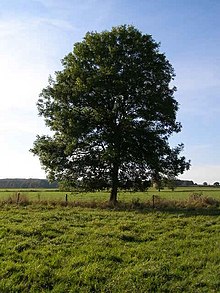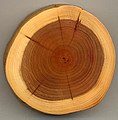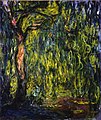The Trees Portal

In botany, a tree is a perennial plant with an elongated stem, or trunk, usually supporting branches and leaves. In some usages, the definition of a tree may be narrower, including only woody plants with secondary growth, plants that are usable as lumber or plants above a specified height. In wider definitions, the taller palms, tree ferns, bananas, and bamboos are also trees.
Trees are not a monophyletic taxonomic group but consist of a wide variety of plant species that have independently evolved a trunk and branches as a way to tower above other plants to compete for sunlight. The majority of tree species are angiosperms or hardwoods; of the rest, many are gymnosperms or softwoods. Trees tend to be long-lived, some reaching several thousand years old. Trees have been in existence for 370 million years. It is estimated that there are around three trillion mature trees in the world.
A tree typically has many secondary branches supported clear of the ground by the trunk, which typically contains woody tissue for strength, and vascular tissue to carry materials from one part of the tree to another. For most trees it is surrounded by a layer of bark which serves as a protective barrier. Below the ground, the roots branch and spread out widely; they serve to anchor the tree and extract moisture and nutrients from the soil. Above ground, the branches divide into smaller branches and shoots. The shoots typically bear leaves, which capture light energy and convert it into sugars by photosynthesis, providing the food for the tree's growth and development.
Trees usually reproduce using seeds. Flowers and fruit may be present, but some trees, such as conifers, instead have pollen cones and seed cones. Palms, bananas, and bamboos also produce seeds, but tree ferns produce spores instead.
Trees play a significant role in reducing erosion and moderating the climate. They remove carbon dioxide from the atmosphere and store large quantities of carbon in their tissues. Trees and forests provide a habitat for many species of animals and plants. Tropical rainforests are among the most biodiverse habitats in the world. Trees provide shade and shelter, timber for construction, fuel for cooking and heating, and fruit for food as well as having many other uses. In much of the world, forests are shrinking as trees are cleared to increase the amount of land available for agriculture. Because of their longevity and usefulness, trees have always been revered, with sacred groves in various cultures, and they play a role in many of the world's mythologies. (Full article...)
Maple syrup is a syrup made from the sap of maple trees. In cold climates, these trees store starch in their trunks and roots before winter; the starch is then converted to sugar that rises in the sap in late winter and early spring. Maple trees are tapped by drilling holes into their trunks and collecting the sap, which is processed by heating to evaporate much of the water, leaving the concentrated syrup.
Maple syrup was first made by the Indigenous peoples of Northeastern North America. The practice was adopted by European settlers, who gradually changed production methods. Technological improvements in the 1970s further refined syrup processing. Virtually all of the world's maple syrup is produced in Canada and the United States. The Canadian province of Quebec is the largest producer, responsible for 70 per cent of the world's output; Canadian exports of maple syrup in 2016 were C$487 million (about US$360 million), with Quebec accounting for some 90 per cent of this total. (Full article...)Did you know? -
- ... that the Paget Marsh Nature Reserve in Bermuda has been called the "best surviving example of native cedar, palmetto (pictured), and mangrove forests", yet at one point the island lost 99% of its cedar trees?
- ... that a canopy walkway connects seven tree tops in Ghana's Kakum National Park?
- ... that the ivory curl tree can grow 30 m (100 ft) tall in its natural rainforest habitat?
- ... that the trumpet tree, a fast-growing tree native to the American tropics, is considered one of the hundred worst invasive alien species in the world?
- ... that the installation of an artificial Christmas tree in Brussels prompted an online petition against it with 25,000 signatures?
- ... that a white oak tree with a trunk circumference of over 26 feet (7.9 m) grew near Wolf Run until it was cut down in 1852?
- ... that the blue nuthatch (pictured) protects its corneas from falling debris when prospecting on trees by contracting the bare skin around its eyes – an adaptation apparently unique to the species?
Selected article -
Sequoia sempervirens (/səˈkwɔɪ.ə ˌsɛmpərˈvaɪrənz/) is the sole living species of the genus Sequoia in the cypress family Cupressaceae (formerly treated in Taxodiaceae). Common names include coast redwood, coastal redwood and California redwood. It is an evergreen, long-lived, monoecious tree living 1,200–2,200 years or more. This species includes the tallest living trees on Earth, reaching up to 115.9 m (380.1 ft) in height (without the roots) and up to 8.9 m (29 ft) in diameter at breast height. These trees are also among the longest-living organisms on Earth. Before commercial logging and clearing began by the 1850s, this massive tree occurred naturally in an estimated 810,000 ha (2,000,000 acres) along much of coastal California (excluding southern California where rainfall is not sufficient) and the southwestern corner of coastal Oregon within the United States.
General images
Selected lists
Subcategories
Related portals
Associated Wikimedia
The following Wikimedia Foundation sister projects provide more on this subject:
- Commons
Free media repository - Wikibooks
Free textbooks and manuals - Wikidata
Free knowledge base - Wikinews
Free-content news - Wikiquote
Collection of quotations - Wikisource
Free-content library - Wikispecies
Directory of species - Wikiversity
Free learning tools - Wiktionary
Dictionary and thesaurus















































































